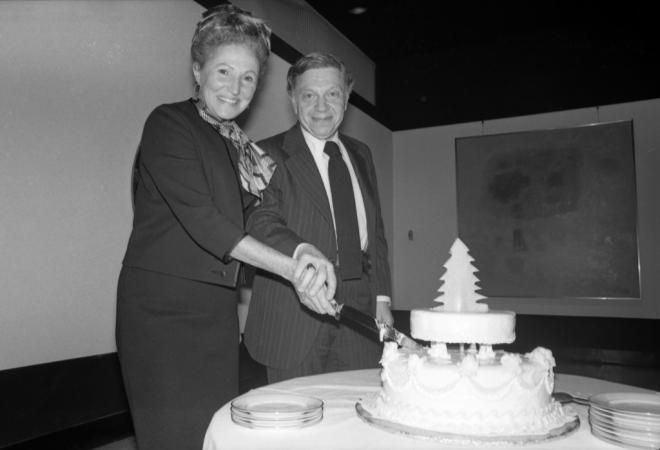It was difficult to surprise Dorothy Rosenberg at Smithsonian Board of Regents meetings. After all, as Smithsonian Secretary S. Dillon Ripley’s executive assistant, she was the one who wrote the agendas for each quarterly gathering. But in September 1979, squeezed in between a discussion about a new policy on gifts for services and the logistics of the next meeting, the Board adopted a resolution, much to the surprise of Rosenberg.
VOTED that the Board of Regents anticipates with regret the retirement of Dorothy Rosenberg from her duties as Executive Assistant to the Secretary and as a mainstay of the Board. In serving the Regents for over two decades Mrs. Rosenberg has been effective through exceptional soundness of judgment, resourcefulness, devotion to the ideals of the Institution, and, above all, unfailing graciousness. With gratitude and respect, the Regents wish her all happiness in the future.
This gesture was just one of many by the Institution to acknowledge Rosenberg’s contributions. In September 1979, she earned the Secretary’s Gold Medal for Exceptional Service, the highest honor presented to Smithsonian staff by the Secretary for outstanding service over a long period of time. Two months later, an article about Rosenberg, titled “Fond Words as Friend Leaves,” was prominently featured in The Torch, Smithsonian’s staff newsletter. That same tribute was reprinted in the December 11, 1979 Congressional Record. Finally, in January 1980, the Smithsonian Institution Women’s Council hosted a reception to celebrate Rosenberg’s retirement.

The sheer amount of acknowledgments of Rosenberg’s retirement demonstrates how respected she was by her colleagues, many of whom were the Smithsonian’s top leaders. Let’s take a look back at her more than 21 years with the Smithsonian.
After nine years with the Department of the Interior, Dorothy Rosenberg joined the Smithonian in 1959 as the administrative officer to Assistant Secretary James C. Bradley. She worked alongside Bradley until 1971, when she became the administrative officer to Assistant Secretary Robert A. Brooks. Rosenberg adopted even more responsibility in her next role as the executive assistant to Secretary Ripley in 1973, when she began managing the entire Office of the Secretary.
Throughout her time with Brooks, Bradley, and Ripley, Rosenberg acted as a liaison to the Smithsonian Board of Regents, where she was often notably the only woman at the table. It was not until 1977, three years before Rosenberg’s retirement, that Representative Corinne Claiborne Boggs became the first woman to be appointed to the Board. In each of the Board’s meeting minutes, Rosenberg’s name is neatly typed at the end of an attendance list of powerful men, which typically includes Chief Justice Warren E. Burger, various corporate executives, and Smithsonian leaders.

As Archives historian Pam Henson noted in a recent blog post, the titles of women administrators at the Smithsonian don’t always accurately capture their responsibilities. In reality, Henson argues, they keep “the Institution humming.” And testimonies from the Institution’s top leaders prove how instrumental Rosenberg was to the Smithsonian. Secretary Ripley stated, “How do you bestow encomiums on someone who deserves them all?” Other leaders around the Institution expressed similar praise. “I simply can’t imagine what this place will be without her,” Assistant Secretary for History and Art Charles Blitzer explained, “but I do know that my life will be more difficult and less pleasant.” Assistant Treasurer Betty J. Morgan put it most succinctly: “She is a low-keyed dynamo.”
Following her retirement, Rosenberg continued to work with Secretary Ripley, and later Secretary Robert McCormick Adams, as a contractor. From 1980 until 1986, she prepared a history of the Board of Regents and of Secretary Ripley’s tenure, the files of which make up the Dorothy Rosenberg Papers at the Smithsonian Institution Archives.
Related Collections
- Dorothy Rosenberg Papers, 1963–1984, Record Unit 7447, Smithsonian Institution Archives
- The Torch, October 1979, Smithsonian Institution Archives
- The Torch, November 1979, Smithsonian Institution Archives
- The Torch, December 1979, Smithsonian Institution Archives
Related Resources
- “Celebrating Smithsonian Women in Women’s History Month,” by Pamela Henson, Smithsonian Collections Blog
- “You May Rest Assured that Adela Gómez Will Take Care of Everything” by Hannah Byrne, The Bigger Picture, Smithsonian Institution Archives
- “Women Managing the Smithsonian,” by Pamela Henson, The Bigger Picture, Smithsonian Institution Archives
Produced by the Smithsonian Institution Archives. For copyright questions, please see the Terms of Use.

Leave a Comment